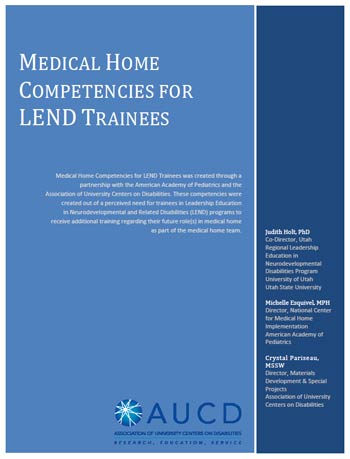Medical Home Competencies for LEND Trainees
October 30, 2010

|
| Download |
|
|
Medical Home Competencies for LEND Trainees was created in 2009-2010 through a partnership with the American Academy of Pediatrics and the Association of University Centers on Disabilities. These competencies were created out of a perceived need for trainees in Leadership Education in Neurodevelopmental and Related Disabilities (LEND) programs to receive additional training regarding their future role(s) in medical home-as part of the medical home team.
The American Academy of Pediatrics (AAP) believes that the medical care of infants, children, and adolescents ideally should be accessible, continuous, comprehensive, family-centered, coordinated, compassionate, and culturally effective. It should be delivered or directed by well-trained physicians who provide primary care and help to manage and facilitate essentially all aspects of pediatric care. The physician should be known to the child and family, and should be able to develop a partnership of mutual responsibility and trust with them. These characteristics define the "medical home."
Related to the interdisciplinary work that LEND trainees will be engaged in, the following is at the foundation of this effort-provision of care coordination services in which the family, physician, and other service providers work to implement a specific care plan as an organized team. The ultimate goal of this initiative is to ensure better coordination of care, via participation of an interdisciplinary team, within the medical home. It is essential for trainees to understand the core tenets of medical home and how they apply to their respective fields of expertise to ensure high-quality work as part of the medical home team.
LEND curriculum and the medical home model intersect in many areas, namely interdisciplinary teamwork and service provision, family-centered care, cultural competency, and leadership in policy and advocacy. These are concepts all LEND trainees are well versed in, regardless of their discipline, area of emphasis, or degree level. Because these areas are also the core areas of a medical home, many LEND trainees use the basic concepts of a medical home model in their careers-because they often overlap with the values used in providing other health care related services-even though it may not have been labeled "medical home training" during their coursework.
But there is more to a medical home than these four areas. Medical home competencies were written in order to ensure that LEND trainees have an understanding of, appreciation for, and experience in the medical home model of practice. Specifically, these competencies focus on the parts of a medical home that do not overlap with general LEND instruction.
With the support of the Maternal and Child Health Bureau (MCHB), a group of LEND Directors, in partnership with staff from the American Academy of Pediatrics and the National Center for Medical Home Implementation, began working on the development of medical home competencies in January 2009. After examining LEND curricula, existing LEND competencies in Maternal Child Health Leadership, and AAP documentation on the medical home, the group was confident that through basic LEND instruction, LEND trainees are able to achieve a high level of understanding and competency in the areas of greatest conceptual and curricular overlap: (1) interdisciplinary teamwork and service provision, (2) family-centered care, (3) cultural competency, and (4) leadership in policy and advocacy. Setting these areas aside, the group found three competency areas that are unique to the medical home and where they felt trainees would benefit from additional instruction. These areas are (1) the Basic Principles of the Medical Home, (2) Organizational Capacity for CYSHCN and Families, and (3) Transition.
Each of the three competency areas is divided into individual competencies. Each competency includes recommended activities for trainees in both primary health care and allied health tracks to acquire the skill or knowledge. Recommended resources for completing the activity and for further learning are included for each competency.







